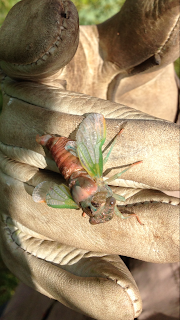(This post is from August 2013. I edited it recently, which made it appear as if it was from January 2014.)
This week I helped eradicate some patches of black locust, an invasive species, from the refuge. The YCC cut the stems with loppers, and then we followed behind and treated the stumps with chemical.
This week I helped eradicate some patches of black locust, an invasive species, from the refuge. The YCC cut the stems with loppers, and then we followed behind and treated the stumps with chemical.
Cicada
We stumbled upon this little guy when we were treating locust. My guess is that it's a cicada that had recently shed its exoskeleton.
Mourning Dove
We've also been trying to trap and band Mourning Doves. We finally caught some this week! I got to release one. IT WAS SO MAGICAL.
Other projects include mapping thistle, checking water levels, data entry, and doing some maintenance and car washing.
Environmental Education Building Site
Our maintenance guys are busy doing the prep work for a new environmental education building that should be constructed next fiscal year. This is a MAT Team project, meaning that maintenance guys from other refuges come in to help!
On Thursday we had a going-away picnic for myself and the YCC. The refuge staff got me a fishing pole as a going away present! I was super surprised and am so excited to try it out in Ohio!
Wow. My last week has come to an end. I can't believe it! Time really flew.
One of the best things about my time at Sherburne this summer was that I got a well-rounded experience. Yes, I was a biological intern, but I also got to spend a good amount of time with the other departments that make up a refuge. I put in work with our maintenance guys, and found that I really like working with my hands. I tried my hand at visitor services, and found that I really appreciate the field of environmental education. I got to explore a diversity of fields and occupations through this internship, and I really appreciate that.
I could never put into words how much I appreciate all of the staff and mentors who took the time to teach, assist, and guide me throughout this program. I’ll definitely never forget my summer at Sherburne.
This will be my last post on this blog. Thanks for keeping up with me this summer!

































